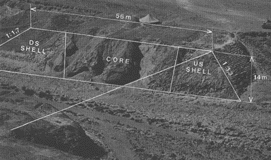Key Developments in the History of
Embankment Dams
|
Ancient Times
Sadd-el-Kafara
The ruins of the Sadd-el-Kafara embankment dam were discovered over 100 years ago in the Garawi
ravine in Egypt. The dam was built around 2600 BC and was 14 m high and 113 m along the crest.
It is the oldest dam of such size known in the world. The of the dam was to retain the water
from rare, but violent, floods. |

The Sadd-el-Kafara Dam
photo from Schnitter
courtesy of
A.A. Balkema (#)
|
|
The grossly overdesigned cross section of the dam was due to inexperience.
Unfortunately, there was no channel or tunnel to divert the river around the dam
site while it was being built. As a result, the dam was destroyed while still
under construction during one of the rare floods it was intended to control.
The consequences of the dam's failure must have been so grave that the Egyptian
engineers refrained from further dam construction for about eight
centuries.
|
|
The dams was only able to handle relatively moderate and frequent floods. As a result, the
dam was breached quite often by extreme floods which occurred about once every 50 years. After
1300 years of service, the dam failed once again. This time it was not fixed and most of the
50,000 people whose livelihood depended on it had to move.
|
The Postmedieval Europe
Saint Ferreol
The proposal of a large water supply reservoir turned out to be the key to build the
Languedoc canal in France, which connected the Mediterranian Sea with the Atlantic Ocean.
The reservoir would be used to conpensate the losses of water in the canal during the dry
season. After the approval by King Louis XIV, the designs for the canal and dam were
drawn up in 1662. The construction of the Saint Ferreol dam began in 1666 and was
completed in 1675. |

The St. Ferreol Dam
sketch from Schnitter
courtesy of
A.A. Balkema (#)
|
|
The dam consisted of a water retaining wall supported by a
downstream embankment. In case of a too rapid depletion of the reservoir, the water
retaining wall was stabilized by a lower embankment built against the upstream face.
The result may be regarded as an earthen dam with a masonry core. With its height of 36 m,
the Saint Ferreol dam remained the heightest embankment in the world for 165 years!
|
Evolution of Modern Embankment Dams
Embankment dams in the U.S. prior to 1930 had a poor track record. Of those over
490 ft high, almost 10% failed, usually due to overtopping in a flood. Overtopping is
when the water level in the reservoir reaches maximum height and begins to flow over
the top of the dam.
The South Fork dam in Johnstown,PA was one of the first to use rockfills, or loose rocks,
on the downstream face. This dam failed after being overtopped in 1889, kill over 2000 people.

The introduction of the use of hydraulic fill came sometime around 1869. Earth and
rocks would be transported by pipe to the site and filled into the core of the dam.
There were numerous accidents when cores burst during construction.
Vibrating rollers are now used to compact soil and gravel for embankment dams.
You have reached the end of the Dams section!
Please visit the Cracks, Case Histories, Scenarios,
or Simulation sections by choosing from the side menu.


|


